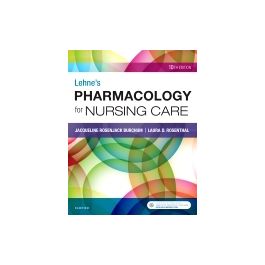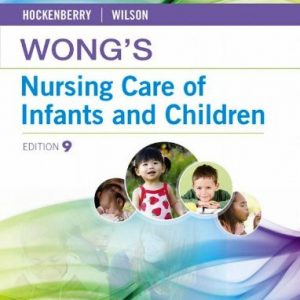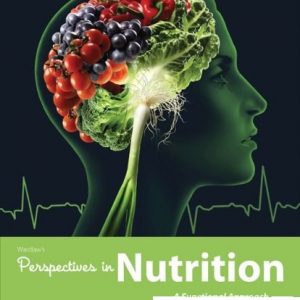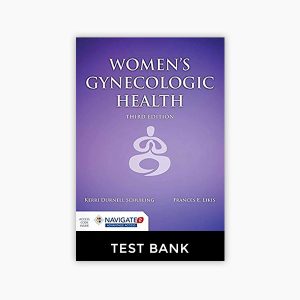This is completed downloadable of Test Bank for Lehnes Pharmacology for Nursing Care 10th Edition By Burchum

Product Details:
- ISBN-10 : 0323512275
- ISBN-13 : 978-0323512275
- Author: Jacqueline Burchum
With a clear explanation of drug prototypes and how they work, Lehne’s Pharmacology for Nursing Care, 10th Edition gives you the background you need to understand drugs currently on the market, and those not yet released. This perennial favorite of students and teachers simplifies complex concepts while distinguishing need-to-know content from the material that’s merely nice to know. The 10th edition includes updated drug content to reflect the very latest FDA approvals, withdrawals, and therapeutic uses, as well as corresponding updated nursing content. It also includes an updated prototype drugs section, summarizing their major uses, and an updated table detailing care throughout the lifespan of the patient. Additionally, each chapter ends with a nursing implications summary to help you fully understand the material and apply it to clinical nursing practice.
- Prototype Drugs features serve as a quick-reference learning aid so you can apply your understanding to related drugs currently on the market as well as drugs that will be released in the future.
- UNIQUE! Engaging writing style with clear explanations makes difficult pharmacology concepts easy to grasp and even enjoyable to learn.
- Nursing implications of drug therapy are integrated throughout the text to reinforce the integral relationship between drug therapy and nursing care.
- UPDATED Special Interest Topic boxes focus on currently trending issues in pharmacology, eliminating out-of-date content.
- Large print highlights essential, need-to-know information, and small print indicates nice-to-know information.
- QSEN focus includes Patient-Centered Care Across the Life Span featureshighlighting safe and appropriate patient care during different phases of life.
- Safety Alert features emphasize the QSEN competency relating to patient safety.
- Student-friendly features make learning easier with concise drug summary tables, chapter outlines, key points, and a visual guide to the prototype drugs in each class.
- Concise drug summary tables present detailed information for individual drugs, including drug class, generic and trade names, dosages, routes, and indications.
- Selected Canadian drug names are indicated with a maple-leaf icon throughout the text.
- Separate Bioterrorism chapter discusses the clinical manifestations and treatment of biological weapon attacks.
- NEW! Thoroughly updated drug content reflects the very latest FDA drug approvals, withdrawals, and therapeutic uses, as well as corresponding updated nursing content
- NEW! Additional images included to accompany difficult concepts.
- NEW! Inclusion of more student practice questions provide additional help for learning the material.
Table of Content:
- Chapter 1 Orientation to Pharmacology
- Four Basic Terms
- Properties of an Ideal Drug
- The Therapeutic Objective
- Factors That Determine the Intensity of Drug Responses
- Key Points
- Chapter 2 Application of Pharmacology in Nursing Practice
- Evolution of Nursing Responsibilities Regarding Drugs
- Application of Pharmacology in Patient Care
- Application of Pharmacology in Patient Education
- Application of the Nursing Process in Drug Therapy
- Key Points
- Chapter 3 Drug Regulation, Development, Names, and Information
- Landmark Drug Legislation
- Hazardous Drug Exposure
- New Drug Development
- Drug Names
- Over-the-Counter Drugs
- Sources of Drug Information
- Key Points
- Unit II Basic Principles of Pharmacology
- Chapter 4 Pharmacokinetics
- Application of Pharmacokinetics in Therapeutics
- A Note to Chemophobes
- Passage of Drugs Across Membranes
- Absorption
- Distribution
- Metabolism
- Excretion
- Time Course of Drug Responses
- Key Points
- Chapter 5 Pharmacodynamics
- Dose-Response Relationships
- Drug-Receptor Interactions
- Drug Responses That Do Not Involve Receptors
- Interpatient Variability in Drug Responses
- The Therapeutic Index
- Key Points
- Chapter 6 Drug Interactions
- Drug-Drug Interactions
- Drug-Food Interactions
- Drug-Supplement Interactions
- Key Points
- Chapter 7 Adverse Drug Reactions and Medication Errors
- Adverse Drug Reactions
- Medication Errors
- Key Points
- Chapter 8 Individual Variation in Drug Responses
- Body Weight and Composition
- Age
- Pathophysiology
- Tolerance
- Placebo Effect
- Variability in Absorption
- Genetics and Pharmacogenomics
- Gender- and Race-Related Variations
- Comorbidities and Drug Interactions
- Diet
- Failure to Take Medicine as Prescribed
- Key Points
- Unit III Drug Therapy Across The Life Span
- Chapter 9 Drug Therapy During Pregnancy and Breast-Feeding
- Drug Therapy During Pregnancy: Basic Considerations
- Drug Therapy During Pregnancy: Teratogenesis
- Drug Therapy During Breast-Feeding
- Key Points
- Chapter 10 Drug Therapy in Pediatric Patients
- Pharmacokinetics: Neonates and Infants
- Pharmacokinetics: Children 1 Year and Older
- Adverse Drug Reactions
- Dosage Determination
- Promoting Adherence
- Key Points
- Chapter 11 Drug Therapy in Older Adults
- Pharmacokinetic Changes in Older Adults
- Pharmacodynamic Changes in Older Adults
- Adverse Drug Reactions and Drug Interactions
- Promoting Adherence
- Considerations for End-of-Life Care
- Key Points
- Unit IV Peripheral Nervous System Drugs
- Section 1 Introduction
- Chapter 12 Basic Principles of Neuropharmacology
- How Neurons Regulate Physiologic Processes
- Basic Mechanisms by Which Neuropharmacologic Agents Act
- Multiple Receptor Types and Selectivity of Drug Action
- An Approach to Learning About Peripheral Nervous System Drugs
- Key Points
- Chapter 13 Physiology of the Peripheral Nervous System
- Divisions of the Nervous System
- Overview of Autonomic Nervous System Functions
- Basic Mechanisms By Which the Autonomic Nervous System Regulates Physiologic Processes
- Anatomic Considerations
- Introduction to Transmitters of the Peripheral Nervous System
- Introduction to Receptors of the Peripheral Nervous System
- Exploring the Concept of Receptor Subtypes
- Locations of Receptor Subtypes
- Functions of Cholinergic and Adrenergic Receptor Subtypes
- Transmitter Life Cycles
- Key Points
- Section 2 Cholinergic Drugs
- Chapter 14 Muscarinic Agonists and Antagonists
- Introduction to Cholinergic Drugs
- Muscarinic Agonists and Antagonists
- Summary of Major Nursing Implications
- Chapter 15 Cholinesterase Inhibitors and Their Use in Myasthenia Gravis
- Reversible Cholinesterase Inhibitors
- Irreversible Cholinesterase Inhibitors
- Myasthenia Gravis
- Key Points
- Summary of Major Nursing Implications
- Chapter 16 Drugs That Block Nicotinic Cholinergic Transmission
- Control of Muscle Contraction
- Competitive (Nondepolarizing) Neuromuscular Blockers
- Depolarizing Neuromuscular Blockers: Succinylcholine
- Therapeutic Uses of Neuromuscular Blockers
- Key Points
- Summary of Major Nursing Implications
- Section 3 Adrenergic Drugs
- Chapter 17 Adrenergic Agonists
- Mechanisms of Adrenergic Receptor Activation
- Overview of the Adrenergic Agonists
- Therapeutic Applications and Adverse Effects of Adrenergic Receptor Activation
- Properties of Representative Adrenergic Agonists
- Key Points
- Summary of Major Nursing Implications
- Chapter 18 Adrenergic Antagonists
- Alpha-Adrenergic Antagonists
- Beta-Adrenergic Antagonists
- Summary of Major Nursing Implications
- Chapter 19 Indirect-Acting Antiadrenergic Agents
- Centrally Acting Alpha2 Agonists
- Adrenergic Neuron-Blocking Agents
- Key Points
- Summary of Major Nursing Implications
- Unit V Central Nervous System Drugs
- Section 4 Introduction
- Chapter 20 Introduction to Central Nervous System Pharmacology
- Transmitters of the CNS
- The Blood-Brain Barrier
- How Do CNS Drugs Produce Therapeutic Effects?
- Adaptation of the CNS to Prolonged Drug Exposure
- Development of New Psychotherapeutic Drugs
- Approaching the Study of CNS Drugs
- Key Points
- Section 5 Drugs for Neurodegenerative Disorders
- Chapter 21 Drugs for Parkinson Disease
- Pathophysiology That Underlies Motor Symptoms
- Overview of Motor Symptom Management
- Pharmacology of Drugs Used for Motor Symptoms
- Nonmotor Symptoms and Their Management
- Key Points
- Summary of Major Nursing Implications
- Chapter 22 Drugs for Alzheimer’s Disease
- Pathophysiology
- Risk Factors and Symptoms
- Drugs for Cognitive Impairment
- Drugs for Neuropsychiatric Symptoms
- Can We Prevent Alzheimer’s Disease or Delay Cognitive Decline?
- Key Points
- Chapter 23 Drugs for Multiple Sclerosis
- Overview of MS and Its Treatment
- Disease-Modifying Drugs I: Immunomodulators
- Disease-Modifying Drugs II: Immunosuppressants
- Drugs Used to Manage MS Symptoms
- Key Points
- Summary of Major Nursing Implications
- Section 6 Neurologic Drugs
- Chapter 24 Drugs for Seizure Disorders
- Seizure Generation
- Types of Seizures
- How Antiepileptic Drugs Work
- Basic Therapeutic Considerations
- Classification of Antiepileptic Drugs
- Traditional Antiepileptic Drugs
- Newer Antiepileptic Drugs
- Management of Generalized Convulsive Status Epilepticus
- Key Points
- Summary of Major Nursing Implications
- Chapter 25 Drugs for Muscle Spasm and Spasticity
- Drugs for Spasticity
- Drugs for Localized Muscle Spasm
- Other Centrally Acting Muscle Relaxants
- Key Points
- Summary of Major Nursing Implications
- Section 7 Drugs for Pain
- Chapter 26 Local Anesthetics
- Basic Pharmacology of Local Anesthetics
- Properties of Individual Local Anesthetics
- Clinical Use of Local Anesthetics
- Key Points
- Summary of Major Nursing Implications
- Chapter 27 General Anesthetics
- Inhalation Anesthetics
- Intravenous Anesthetics
- Summary of Major Nursing Implications
- Chapter 28 Opioid Analgesics, Opioid Antagonists, and Nonopioid Centrally Acting Analgesics
- Opioid Analgesics
- Opioid Antagonists
- Nonopioid Centrally Acting Analgesics
- Summary of Major Nursing Implications
- Chapter 29 Pain Management in Patients With Cancer
- Pathophysiology of Pain
- Management Strategy
- Assessment and Ongoing Evaluation
- Drug Therapy
- Nondrug Therapy
- Pain Management in Special Populations
- Patient Education
- The Joint Commission Pain Management Standards
- Key Points
- Chapter 30 Drugs for Headache
- Migraine Headache
- Cluster Headaches
- Tension-Type Headache
- Summary of Major Nursing Implications
- Section 8 Psychotherapeutic Drugs
- Chapter 31 Antipsychotic Agents and Their Use in Schizophrenia
- Schizophrenia: Clinical Presentation and Etiology
- First-Generation (Conventional) Antipsychotics
- Second-Generation (Atypical) Antipsychotics
- Depot Antipsychotic Preparations
- Management of Schizophrenia
- Key Points
- Summary of Major Nursing Implications
- Chapter 32 Antidepressants
- Major Depression: Clinical Features, Pathogenesis, and Treatment Overview
- Drugs Used for Depression
- Somatic (Nondrug) Therapies for Depression
- Summary of Major Nursing Implications
- Chapter 33 Drugs for Bipolar Disorder
- Characteristics of Bipolar Disorder
- Treatment of Bipolar Disorder
- Mood-Stabilizing Drugs
- Antipsychotic Drugs
- Key Points
- Summary of Major Nursing Implications
- Chapter 34 Sedative-Hypnotic Drugs
- Benzodiazepines
- Benzodiazepine-Like Drugs
- Ramelteon: A Melatonin Agonist
- Suvorexant: An Orexin Antagonist
- Barbiturates
- Management of Insomnia
- Key Points
- Summary of Major Nursing Implications
- Chapter 35 Management of Anxiety Disorders
- Generalized Anxiety Disorder
- Panic Disorder
- Obsessive-Compulsive Disorder
- Social Anxiety Disorder (Social Phobia)
- Post-Traumatic Stress Disorder
- Key Points
- Chapter 36 Central Nervous System Stimulants and Attention-Deficit/Hyperactivity Disorder
- Central Nervous System Stimulants
- Attention-Deficit/Hyperactivity Disorder
- Summary of Major Nursing Implications
- Section 9 Drug Abuse
- Chapter 37 Substance Use Disorders I
- Definitions
- Diagnostic Criteria Regarding Substance Use Disorder
- Factors That Contribute to Substance Use Disorder
- Neurobiology of Substance Use Disorder
- Principles of Substance Use Disorder Treatment
- The Controlled Substances Act
- Key Points
- Chapter 38 Substance Use Disorders II
- Basic Pharmacology of Alcohol
- Alcohol Use Disorder (AUD)
- Drugs for Alcohol Use Disorder
- Key Points
- Summary of Major Nursing Implications
- Chapter 39 Substance Use Disorders III
- Basic Pharmacology of Nicotine
- Pharmacologic Aids to Smoking Cessation
- Key Points
- Chapter 40 Substance Use Disorders IV
- Heroin, Oxycodone, and Other Opioids
- General CNS Depressants
- Psychostimulants
- Marijuana and Related Preparations
- Psychedelics
- Dissociative Drugs
- Dextromethorphan
- 3,4-Methylenedioxymethamphetamine (MDMA, Ecstasy)
- Inhalants
- Anabolic Steroids
- Key Points
- Unit VI Drugs That Affect Fluid and Electrolyte Balance
- Chapter 41 Diuretics
- Review of Renal Anatomy and Physiology
- Introduction to Diuretics
- Loop Diuretics
- Thiazides and Related Diuretics
- Potassium-Sparing Diuretics
- Mannitol: an Osmotic Diuretic
- Key Points
- Summary of Major Nursing Implications
- Chapter 42 Agents Affecting the Volume and Ion Content of Body Fluids
- Disorders of Fluid Volume and Osmolality
- Acid-Base Disturbances
- Potassium Imbalances
- Magnesium Imbalances
- Key Points
- Unit VII Drugs That Affect the Heart, Blood Vessels, and Blood
- Chapter 43 Review of Hemodynamics
- Overview of the Circulatory System
- Regulation of Cardiac Output
- Regulation of Arterial Pressure
- Key Points
- Chapter 44 Drugs Acting on the Renin-Angiotensin-Aldosterone System
- Physiology of the Renin-Angiotensin-Aldosterone System
- Angiotensin-Converting Enzyme Inhibitors
- Angiotensin II Receptor Blockers
- Aliskiren, a Direct Renin Inhibitor
- Aldosterone Antagonists
- Key Points
- Summary of Major Nursing Implications
- Chapter 45 Calcium Channel Blockers
- Calcium Channels: Physiologic Functions and Consequences of Blockade
- Calcium Channel Blockers: Classification and Sites of Action
- Verapamil and Diltiazem: Agents That Act on Vascular Smooth Muscle and the Heart
- Dihydropyridines: Agents That Act Mainly on Vascular Smooth Muscle
- Key Points
- Summary of Major Nursing Implications
- Chapter 46 Vasodilators
- Basic Concepts in Vasodilator Pharmacology
- Pharmacology of Individual Vasodilators
- Key Points
- Chapter 47 Drugs for Hypertension
- Basic Considerations in Hypertension
- Management of Chronic Hypertension
- Drugs for Hypertensive Emergencies
- Drugs for Hypertensive Disorders of Pregnancy
- Summary of Major Nursing Implications
- Chapter 48 Drugs for Heart Failure
- Pathophysiology of Heart Failure
- Overview of Drugs Used to Treat Heart Failure
- Digoxin, a Cardiac Glycoside
- Management of Heart Failure
- Key Points
- Summary of Major Nursing Implications
- Chapter 49 Antidysrhythmic Drugs
- Cardiac Electrophysiology, Dysrhythmias, and the Antidysrhythmic Drugs
- Pharmacology of the Antidysrhythmic Drugs
- Summary of Major Nursing Implications
- Chapter 50 Prophylaxis of Atherosclerotic Cardiovascular Disease
- Cholesterol
- Plasma Lipoproteins
- Role of LDL Cholesterol in Atherosclerosis
- 2013 ACC/AHA Guidelines on the Treatment of Blood Cholesterol to Reduce Atherosclerotic Cardiovascular Risk
- Drugs and Other Products Used to Improve Plasma Lipid Levels
- Key Points
- Summary of Major Nursing Implications
- Chapter 51 Drugs for Angina Pectoris
- Determinants of Cardiac Oxygen Demand and Oxygen Supply
- Angina Pectoris: Pathophysiology and Treatment Strategy
- Organic Nitrates
- Beta Blockers
- Calcium Channel Blockers
- Ranolazine
- Treatment Measures
- Key Points
- Summary of Major Nursing Implications
- Chapter 52 Anticoagulant, Antiplatelet, and Thrombolytic Drugs
- Coagulation: Physiology and Pathophysiology
- Overview of Drugs for Thromboembolic Disorders
- Summary of Major Nursing Implications
- Chapter 53 Management of ST-Elevation Myocardial Infarction
- Pathophysiology of STEMI
- Diagnosis of STEMI
- Management of STEMI
- Complications of STEMI
- Secondary Prevention of STEMI
- Key Points
- Chapter 54 Drugs for Hemophilia
- Basic Considerations
- Preparations Used to Treat Hemophilia
- Key Points
- Summary of Major Nursing Implications
- Chapter 55 Drugs for Deficiency Anemias
- Red Blood Cell Development
- Iron Deficiency
- Vitamin B12 Deficiency
- Folic Acid Deficiency
- Summary of Major Nursing Implications
- Chapter 56 Hematopoietic Agents
- Hematopoietic Growth Factors
- Drugs That Mimic Hematopoietic Growth Factors or Enhance Their Actions
- Summary of Major Nursing Implications
- Unit VIII Drugs for Endocrine Disorders
- Chapter 57 Drugs for Diabetes Mellitus
- Diabetes Mellitus
- Insulin
- Non-Insulin Medications for the Treatment of Diabetes
- Acute Complications of Poor Glycemic Control
- Glucagon for Treatment of Severe Hypoglycemia
- Summary of Major Nursing Implications
- Chapter 58 Drugs for Thyroid Disorders
- Thyroid Physiology
- Thyroid Function Tests
- Thyroid Pathophysiology
- Thyroid Hormone Preparations for Hypothyroidism
- Drugs for Hyperthyroidism
- Key Points
- Summary of Major Nursing Implications
- Chapter 59 Drugs Related to Hypothalamic and Pituitary Function
- Overview of Hypothalamic and Pituitary Endocrinology
- Growth Hormone
- Mecasermin (Insulin-Like Growth Factor-1)
- Prolactin
- Antidiuretic Hormone (Vasopressin)
- Antidiuretic Hormone (Vasopressin) Antagonists
- Drugs for Acromegaly
- Key Points
- Summary of Major Nursing Implications
- Chapter 60 Drugs for Disorders of the Adrenal Cortex
- Physiology of the Adrenocortical Hormones
- Pathophysiology of the Adrenocortical Hormones
- Agents for Replacement Therapy in Adrenocortical Insufficiency
- Agents for Diagnosing Adrenocortical Disorders
- Key Points
- Summary of Major Nursing Implications
- Unit IX Women’s Health
- Chapter 61 Estrogens and Progestins
- The Menstrual Cycle
- Estrogens
- Selective Estrogen Receptor Modulators (SERMs)
- Progestins
- Menopausal Hormone Therapy
- Key Points
- Summary of Major Nursing Implications
- Chapter 62 Birth Control
- Effectiveness of Birth Control Methods
- Selecting a Birth Control Method
- Oral Contraceptives
- Combination Contraceptives With Novel Delivery Systems
- Long-Acting Contraceptives
- Spermicides
- Barrier Devices
- Drugs for Medical Abortion
- Key Points
- Summary of Major Nursing Implications
- Chapter 63 Drug Therapy for Infertility
- Infertility: Causes and Treatment Strategies
- Drugs Used to Treat Female Infertility
- Key Points
- Summary of Major Nursing Implications
- Chapter 64 Drugs That Affect Uterine Function
- Drugs for Preterm Labor
- Drugs for Cervical Ripening and Induction of Labor
- Drugs for Postpartum Hemorrhage
- Drugs for Menorrhagia
- Summary of Major Nursing Implications
- Unit X Men’s Health
- Chapter 65 Androgens
- Testosterone
- Clinical Pharmacology of the Androgens
- Androgen Preparations for Male Hypogonadism
- Androgen (Anabolic Steroid) Abuse by Athletes
- Key Points
- Summary of Major Nursing Implications
- Chapter 66 Drugs for Erectile Dysfunction and Benign Prostatic Hyperplasia
- Erectile Dysfunction
- Benign Prostatic Hyperplasia
- Summary of Major Nursing Implications
- Unit XI Anti-Inflammatory, Antiallergic, and Immunologic Drugs
- Chapter 67 Review of the Immune System
- Introduction to the Immune System
- Antibody-Mediated (Humoral) Immunity
- Cell-Mediated Immunity
- Key Points
- Chapter 68 Childhood Immunization
- General Considerations
- Target Diseases
- Specific Vaccines and Toxoids
- Key Points
- Chapter 69 Immunosuppressants
- Calcineurin Inhibitors
- mTOR Inhibitors
- Glucocorticoids
- Cytotoxic Drugs
- Antibodies
- Key Points
- Summary of Major Nursing Implications
- Chapter 70 Antihistamines
- Histamine
- The Two Types of Antihistamines: H1 Antagonists and H2 Antagonists
- Histamine1 Antagonists I: Basic Pharmacology
- Histamine1 Antagonists Ii: Preparations
- Key Points
- Summary of Major Nursing Implications
- Chapter 71 Cyclooxygenase Inhibitors
- Mechanism of Action
- Classification of Cyclooxygenase Inhibitors
- First-Generation NSAIDs
- Second-Generation NSAIDs (COX-2 Inhibitors, Coxibs)
- Acetaminophen
- AHA Statement on the use of COX Inhibitors for Chronic Pain
- Key Points
- Summary of Major Nursing Implications
- Chapter 72 Glucocorticoids in Nonendocrine Disorders
- Review of Glucocorticoid Physiology
- Pharmacology of the Glucocorticoids
- Key Points
- Summary of Major Nursing Implications
- Unit XII Drugs for Bone and Joint Disorders
- Chapter 73 Drug Therapy for Rheumatoid Arthritis
- Pathophysiology of Rheumatoid Arthritis
- Overview of Therapy
- Nonsteroidal Anti-Inflammatory Drugs
- Glucocorticoids
- Nonbiologic (Traditional) Disease-Modifying Antirheumatic Drugs
- Biologic Disease-Modifying Antirheumatic Drugs
- Key Points
- Summary of Major Nursing Implications
- Chapter 74 Drug Therapy for Gout
- Pathophysiology of Gout
- Overview of Drug Therapy
- Drugs for Acute Gouty Arthritis
- Drugs for Hyperuricemia (Urate-Lowering Therapy)
- Key Points
- Chapter 75 Drugs Affecting Calcium Levels and Bone Mineralization
- Calcium Physiology
- Calcium-Related Pathophysiology
- Drugs for Disorders Involving Calcium and Bone Mineralization
- Osteoporosis
- Key Points
- Summary of Major Nursing Implications
- Unit XIII Respiratory Tract Drugs
- Chapter 76 Drugs for Asthma and Chronic Obstructive Pulmonary Disease
- Basic Considerations
- Anti-Inflammatory Drugs
- Bronchodilators
- Glucocorticoid–Long-Acting Beta2-Agonist Combinations
- Beta2-Adrenergic Agonist–Anticholinergic Combinations
- Management of Asthma
- Management of COPD
- Summary of Major Nursing Implications
- Chapter 77 Drugs for Allergic Rhinitis, Cough, and Colds
- Drugs for Allergic Rhinitis
- Drugs for Cough
- Cold Remedies: Combination Preparations
- Key Points
- Unit XIV Gastrointestinal Drugs
- Chapter 78 Drugs for Peptic Ulcer Disease
- Pathogenesis of Peptic Ulcers
- Overview of Treatment
- Antibacterial Drugs
- Histamine2 Receptor Antagonists
- Proton Pump Inhibitors
- Other Antiulcer Drugs
- Key Points
- Summary of Major Nursing Implications
- Chapter 79 Laxatives
- General Considerations
- Basic Pharmacology of Laxatives
- Laxative Abuse
- Key Points
- Summary of Major Nursing Implications
- Chapter 80 Other Gastrointestinal Drugs
- Antiemetics
- Drugs for Motion Sickness
- Antidiarrheal Agents
- Drugs for Irritable Bowel Syndrome
- Drugs for Inflammatory Bowel Disease
- Prokinetic Agents
- Palifermin
- Pancreatic Enzymes
- Drugs Used to Dissolve Gallstones
- Anorectal Preparations
- Key Points
- Unit XV Nutrition
- Chapter 81 Vitamins
- Basic Considerations
- Fat-Soluble Vitamins
- Water-Soluble Vitamins
- Key Points
- Chapter 82 Drugs for Weight Loss
- Assessment of Weight-Related Health Risk
- Overview of Obesity Treatment
- Weight-Loss Drugs
- A Note Regarding Drugs for Weight Loss
- Key Points
- Unit XVI Chemotherapy of Infectious Diseases
- Chapter 83 Basic Principles of Antimicrobial Therapy
- Selective Toxicity
- Classification of Antimicrobial Drugs
- Acquired Resistance to Antimicrobial Drugs
- Selection of Antibiotics
- Host Factors That Modify Drug Choice, Route of Administration, or Dosage
- Dosage and Duration of Treatment
- Therapy With Antibiotic Combinations
- Prophylactic Use of Antimicrobial Drugs
- Misuses of Antimicrobial Drugs
- Monitoring Antimicrobial Therapy
- Key Points
- Chapter 84 Drugs That Weaken the Bacterial Cell Wall I
- Introduction to the Penicillins
- Properties of Individual Penicillins
- Key Points
- Summary of Major Nursing Implications
- Chapter 85 Drugs That Weaken the Bacterial Cell Wall II
- Cephalosporins
- Carbapenems
- Other Inhibitors of Cell Wall Synthesis
- Key Points
- Summary of Major Nursing Implications
- Chapter 86 Bacteriostatic Inhibitors of Protein Synthesis
- Tetracyclines
- Macrolides
- Other Bacteriostatic Inhibitors of Protein Synthesis
- Key Points
- Summary of Major Nursing Implications
- Chapter 87 Aminoglycosides
- Basic Pharmacology of the Aminoglycosides
- Properties of Individual Aminoglycosides
- Key Points
- Summary of Major Nursing Implications
- Chapter 88 Sulfonamides and Trimethoprim
- Sulfonamides
- Trimethoprim
- Trimethoprim/Sulfamethoxazole
- Key Points
- Summary of Major Nursing Implications
- Chapter 89 Drug Therapy for Urinary Tract Infections
- Organisms That Cause Urinary Tract Infections
- Specific Urinary Tract Infections and Their Treatment
- Urinary Tract Antiseptics
- Key Points
- Chapter 90 Antimycobacterial Agents
- Drugs for Tuberculosis
- Drugs for Leprosy (Hansen’s Disease)
- Drugs for Mycobacterium avium Complex Infection
- Summary of Major Nursing Implications
- Chapter 91 Miscellaneous Antibacterial Drugs
- Fluoroquinolones
- Additional Antibacterial Drugs
- Key Points
- Summary of Major Nursing Implications
- Chapter 92 Antifungal Agents
- Drugs for Systemic Mycoses
- Drugs for Superficial Mycoses
- Key Points
- Summary of Major Nursing Implications
- Chapter 93 Antiviral Agents I
- Drugs for Infection With Herpes Simplex Viruses and Varicella-Zoster Virus
- Drugs for Cytomegalovirus Infection
- Drugs for Hepatitis
- Drugs for Influenza
- Drugs for Respiratory Syncytial Virus Infection
- Summary of Major Nursing Implications
- Chapter 94 Antiviral Agents II
- Pathophysiology
- Classification of Antiretroviral Drugs
- Drug Interactions
- Nucleoside/Nucleotide Reverse Transcriptase Inhibitors
- Non-Nucleoside Reverse Transcriptase Inhibitors
- Protease Inhibitors
- Integrase Strand Transfer Inhibitors
- HIV Fusion Inhibitors
- CCR5 Antagonists
- Management of HIV Infection
- Preventing HIV Infection With Drugs
- Prophylaxis and Treatment of Opportunistic Infections
- HIV Vaccines
- Keeping Current
- Key Points
- Summary of Major Nursing Implications
- Chapter 95 Drug Therapy for Sexually Transmitted Infections
- Chlamydia trachomatis Infections
- Gonococcal Infections
- Nongonococcal Urethritis
- Pelvic Inflammatory Disease
- Acute Epididymitis
- Syphilis
- Acquired Immunodeficiency Syndrome
- Bacterial Vaginosis
- Trichomoniasis
- Chancroid
- Herpes Simplex Virus Infections
- Proctitis
- Venereal Warts
- Making Sense of Treatment
- Key Points
- Chapter 96 Antiseptics and Disinfectants
- General Considerations
- Properties of Individual Antiseptics and Disinfectants
- Hand Hygiene for Healthcare Workers
- Key Points
- Unit XVII Chemotherapy of Parasitic Diseases
- Chapter 97 Anthelmintics
- Classification of Parasitic Worms
- Helminthic Infestations
- Drugs of Choice for Helminthiasis
- Key Points
- Chapter 98 Antiprotozoal Drugs I
- Life Cycle of the Malaria Parasite
- Types of Malaria
- Principles of Antimalarial Therapy
- Pharmacology of the Major Antimalarial Drugs
- Key Points
- Chapter 99 Antiprotozoal Drugs II
- Protozoal Infections
- Drugs of Choice for Protozoal Infections
- Key Points
- Chapter 100 Ectoparasiticides
- Ectoparasitic Infestations
- Pharmacology of Ectoparasiticides
- Key Points
- Unit XVIII Cancer Chemotherapy
- Chapter 101 Basic Principles of Cancer Chemotherapy
- What Is Cancer?
- The Growth Fraction and Its Relationship to Chemotherapy
- Obstacles to Successful Chemotherapy
- Strategies for Achieving Maximum Benefits From Chemotherapy
- Major Toxicities of Chemotherapeutic Drugs
- Making the Decision to Treat
- Looking Ahead
- Key Points
- Chapter 102 Anticancer Drugs I
- Introduction to the Cytotoxic Anticancer Drugs
- Alkylating Agents
- Platinum Compounds
- Antimetabolites
- Hypomethylating Agents
- Antitumor Antibiotics
- Mitotic Inhibitors
- Topoisomerase Inhibitors
- Miscellaneous Cytotoxic Drugs
- Key Points
- Chapter 103 Anticancer Drugs II
- Drugs for Breast Cancer
- Drugs for Prostate Cancer
- Targeted Anticancer Drugs
- Immunostimulants
- Other Noncytotoxic Anticancer Drugs
- Unit XIX Miscellaneous Drugs and Therapies
- Chapter 104 Drugs for the Eye
- Drugs for Glaucoma
- Cycloplegics and Mydriatics
- Drugs for Allergic Conjunctivitis
- Drugs for Age-Related Macular Degeneration
- Additional Ophthalmic Drugs
- Key Points
- Chapter 105 Drugs for the Skin
- Anatomy of the Skin
- Topical Drug Formulations
- Topical Glucocorticoids
- Keratolytic Agents
- Acne
- Drugs for Rosacea
- Sunscreens
- Psoriasis
- Drugs for Actinic Keratoses
- Drugs for Atopic Dermatitis (Eczema)
- Agents Used to Remove Warts
- Drugs for Nonsurgical Cosmetic Procedures
- Antiperspirants and Deodorants
- Drugs for Seborrheic Dermatitis and Dandruff
- Drugs for Hair Loss
- Eflornithine for Unwanted Facial Hair
- Drugs for Impetigo
- Local Anesthetics
- Key Points
- Chapter 106 Drugs for the Ear
- Anatomy of the Ear
- Otitis Media and Its Management
- Otitis Externa and Its Management
- Key Points
- Summary of Major Nursing Implications
- Chapter 107 Additional Noteworthy Drugs
- Drugs for Pulmonary Arterial Hypertension
- Drugs for Neonatal Respiratory Distress Syndrome
- Drugs for Cystic Fibrosis
- Drugs for Sickle Cell Anemia
- Phosphate Binders for Patients on Dialysis
- Gamma-Hydroxybutyrate for Cataplexy in Patients With Narcolepsy
- Riluzole for Amyotrophic Lateral Sclerosis
- Tetrabenazine for Chorea of Huntington’s Disease
- Drugs for Fibromyalgia
- Drugs for Hereditary Angioedema
- Belimumab for Systemic Lupus Erythematosus
- Key Points
- Chapter 108 Complementary and Alternative Therapy
- Regulation of Dietary Supplements
- Private Quality Certification Programs
- Standardization of Herbal Products
- Adverse Interactions With Conventional Drugs
- Some Commonly Used Dietary Supplements
- Harmful Supplements to Avoid
- Key Points
- Unit XX Toxicology
- Chapter 109 Management of Poisoning
- Fundamentals of Treatment
- Drugs and Procedures Used to Minimize Poison Absorption
- Drugs and Procedures Used for Poison Removal
- Specific Antidotes
- Poison Control Centers
- Key Points
- Chapter 110 Potential Weapons of Biologic, Radiologic, and Chemical Terrorism
- Bacteria and Viruses
- Biotoxins
- Chemical Weapons
- Radiologic Weapons
- Key Points
- Appendix A Canadian Drug Information*
- Canadian Drug Legislation
- Drug Advertising
- International System of Units
- Drug Serum Concentrations
- Further Reading
- Appendix B Prototype Drugs and Their Major Uses
- Peripheral Nervous System Drugs
- Central Nervous System Drugs
- Diuretics
- Drugs That Affect the Heart, Blood Vessels, and Blood
- Drugs for Endocrine Disorders
- Women’s Health
- Men’s Health
- Anti-Inflammatory, Antiallergic, and Immunologic Drugs
- Drugs for Bone and Joint Disorders
- Respiratory Tract Drugs
- Gastrointestinal Drugs
- Drugs for Weight Loss
- Drugs for Bacterial Infections
- Drugs for Fungal Infections
- Drugs for Viral Infections
- Drugs for Parasitic Diseases
- Anticancer Drugs: Cytoxic Agents
- Anticancer Drugs: Hormonal Agents, Targeted Drugs, and Other Noncytotoxic Anticancer Drugs
- Other Important Drugs
- Index
- Special Interest Topics





